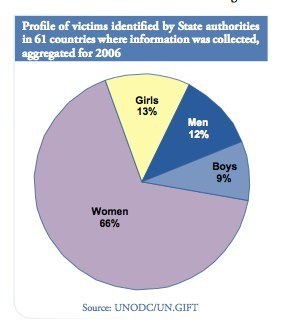Introducing “Women in Chains”
Serendipitous as it might be, I was debating when would be a good time to post about a blog I just started, when I came across this post at the Huffington Post:
Visibility is one of the trickiest issues in advocacy. Anyone who’s worked for a nonprofit knows that getting people to care is really, really hard. Movies are made in the hopes that people will watch them and do something about the issues present. Protests and marathons are held in the hopes of bringing awareness to a topic. But there’s nothing like the awareness that can happen when it’s in your own backyard. And this is why advocates spend a lot of time trying to bring issues home to people.
Visibility serves many important purposes in advocacy. Not only does it motivate people to act, but it also shines a spotlight on every person involved in the issue at hand. In the case of nonconsensual prostitution and human trafficking, this means that those who are engaged in these activities aren’t so deeply underground as to be invisible. They’re right there. And while they feel protected by the theoretical power of anonymity and the belief that no one can physically approach and arrest them, they’re leaving traces of all sorts that make them far easier to find than most underground criminals.
It is in this spirit that I created Women in Chains, a blog about slavery and trafficking of women and girls.

This table, from United Nations Global Report on Trafficking in Persons (can be downloaded at the link) breaks down the percentages of people per gender and age. Of those affected, 79% are women and young girls.
We always talk about privilege and what it means to be privileged. We sometimes do so in abstract terms. In fact, most socio political discussions happen in abstractions. Sometimes these abstractions help deconstruct a paradigm, they allows us to have some emotional distance so that we can look at a series of events or figures like the ones above and identify what exactly is wrong with them and their order of magnitude. However, the abstraction can also detract us from the reality, from what it means to be in a situation of slavery or human trafficking, what it really means to live a life under certain conditions, to what extent the oppression is widespread and how it is everywhere, all around us. And that’s why I started Women in Chains, if only with the hope that the sheer volume of stories and news items will help create awareness. A place to offer little commentary (if any) and instead, link to the stories and news of women and girls in situations of slavery and trafficking on the news, day after day.
I won’t be commenting much over there (unless it’s to point out something obvious or some media representation that should not remain unchallenged). I do not wish the blog to be about me or my beliefs. I just wish for it to be a space where the sheer volume of stories becomes so self evident, so deafening that all we can do is start paying attention, start demanding political changes that revert the oppression and the cycle of abuse. Also, I hope to aggregate every resource, from charities, to NGOs, to government initiatives that help people in situations of slavery and human trafficking claim their lives back.
So far, this is a one person blog, but I count on anyone and everyone to submit news items, stories and organizations to be added to the index.
Women in Chains will never be a source of good news, but I do hope it will be a resource to raise attention.
Submit stories, resources, organizations here.
For the past decade and a half I have been making all my content available for free (and never behind a paywall) as an ongoing practice of ephemeral publishing. This site is no exception. If you wish to help offset my labor costs, you can donate on Paypal or you can subscribe to Patreon where I will not be putting my posts behind a lock but you'd be helping me continue making this work available for everyone. Thank you. Follow me on Twitter for new post updates.

